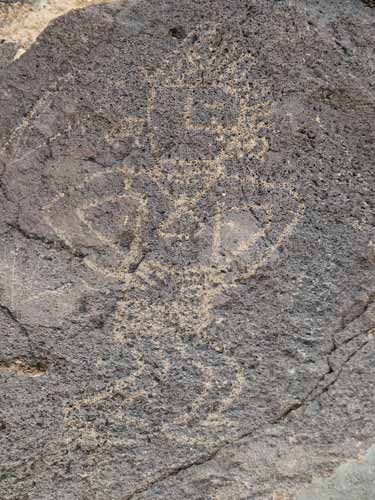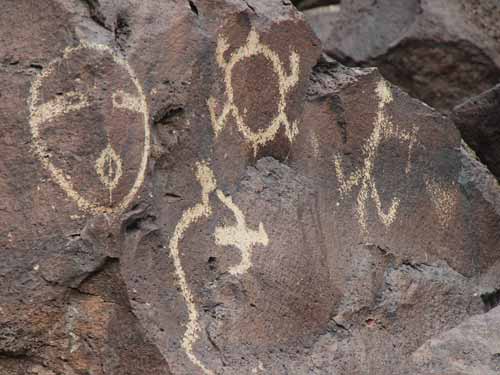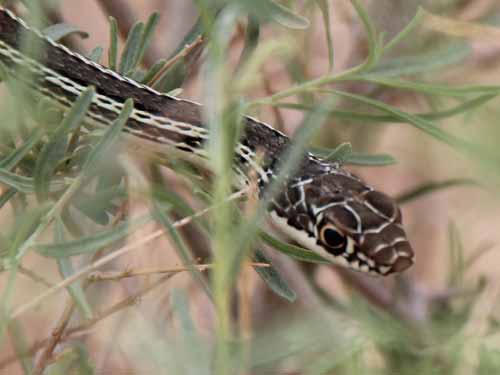The monument contains over 20,000 petroglyphs.These include images of animals, insects, crosses, people and geometric designs. Others are unclear and we will probably never know their meaning. It is estimated that most of these images were made 400 to 700 years ago. Some may be 2,000 to 3,000 years old. Not only did the native tribes leave their mark, Spanish colonists from the 1700's and explores from the 1800's did as well.

This area was created 200,000 years ago by a series of six volcanic eruptions. As the softer rock eroded out from underneath, the basalt tumbled down, forming the escarpment (cliff) on which the petroglyphs are found. The escarpment is still continuing to erode and moving westward, however, the current dry conditions have slowed it down drastically.

The monument has an interesting shape (which basically follows the escarpment) with only a few short trails into it. We decided to try Rinconada Canyon. It was the closest and seem to have a lot of interesting stuff.

Outside the visitor center was a touching rock, so people could get it out of their systems before seeing the real things. The oils from a person's touch can seriously damage these irreplaceable images. Vandalism is also a big problem.

A roadrunner flew up into a tree as we approached. They actually look NOTHING like the famous cartoon.

The Rinconda Canyon Trail is a 2.2-mile unpaved loop trail, going out past the escarpment and back through the center of the valley.

Map showing the locations of various petroglyphs. Archeologists believe the Ancestral Puebloans (who built adobe villages in this area around 1300) made most of the 1,200 petroglyphs in this canyon. The images were probably used to teach their children about history, culture and spiritual beliefs.


Walking along the escarpment comprised of fallen basalt rocks


Petroglyph are made by scraping off of dark desert varnish with a sharp stone, revealing the original lighter rock color underneath. Pictographs, on the other hand, are painted onto the rock. Since it took a long time to chip into the rock with stone tools, each creation had to be carefully planned.

Lighting conditions can dictate whether or not a petroglyph is visible at any given time. Some Pueblo elders believe that the images choose when and to whom to reveal themselves.

Six toes?

Real or fake? Some of the images are easy mistaken for graffiti but aren't. But for us visitors, it's impossible to tell which are which.

This is clearly graffiti...

... but at what point does graffiti (such as this one from 1919) become "historical?"


A deer perhaps? Such cute little feet!





Some are quite obvious;...

... others simply lead to questions.

Gunshot wound? This was apparently a common form of vandalism. There were also plenty of shotgun shells lying about.


In spite of all this artwork, the people did not live here. They lived along the river about two miles east of here.


Sheep weren't introduced to the area until the 1600's. Using this type of information helps people identify the age of a drawing.




We reached the back of the canyon then followed the trail around and back out. This time, it took us through the middle of the valley, away from the escarpment and its petroglyphs.

Evidence of the harsh environment


Looking back down to the end of the valley

The sand was covered with these interesting patterns. ...

... Eventually we found the culprit.

Desert Millipedes are usually active at night, but heavy rainfall can also bring them out during the day.
What's the difference between a centipede and a millipede?
The centipede ("hundred legs") and the millipede ("thousand legs") have common evolutionary roots, which extend back more than 400 million years. They are related to lobsters, shrimp and crayfish. Centipedes are flat, carnivorous (with two venomous legs for catching and killing prey), fast, and have a single pair of legs per segment. Millipedes are rounded, scavenge on decaying organic material and sometimes live plants, are slow, and have two pairs of legs per segment.

The Desert Spider Beetle is a type of Inflated Beetle belonging to the Blister Beetle family.

This Eastern Side-blotched Lizard seems to have lost its tail at some point.

A Desert Cottontail

A snake in the bush!

The Striped Whipsnake is nonvenomous.

This large, black, aggressive flying thing was terrifying even before I learned what it was! Apparently it is a Tarantula Hawk Wasp... and yes, it hunts and kills tarantulas! It is also the state insect of New Mexico.
We sat under an awning at the parking lot and had some lunch before driving off.

